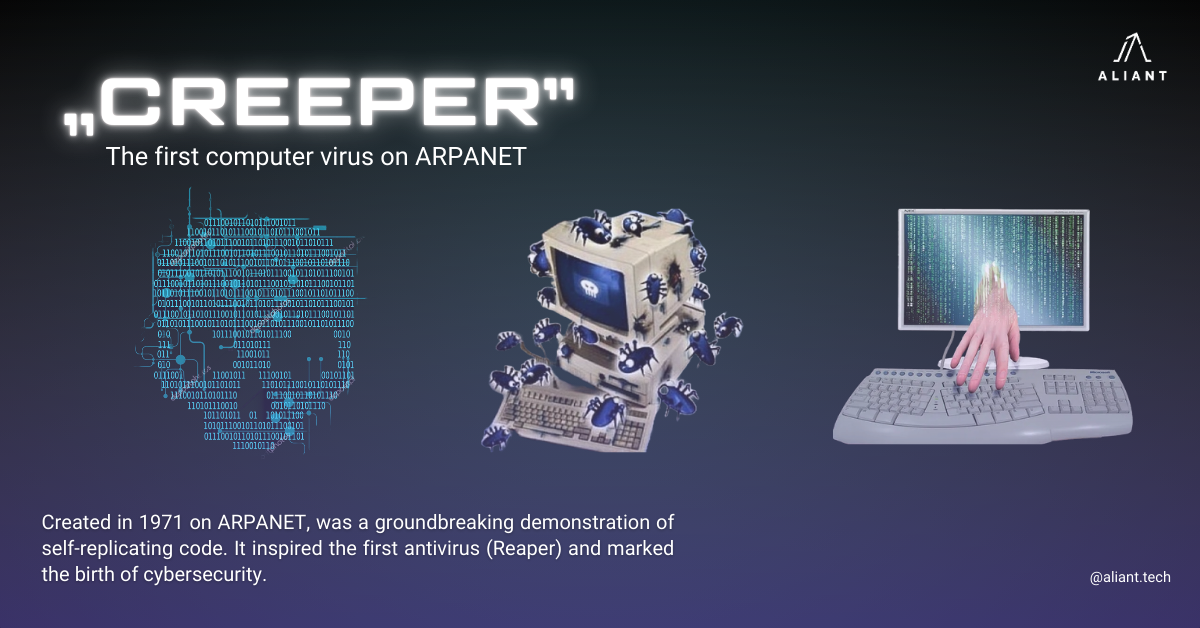The first computer virus – “Creeper” on ARPANET, the beginnings of networks and self-replicating programs. In the early 1970s, computers were used mainly by universities and government institutions. The Internet did not yet exist, but ARPANET, a network created by ARPA (Advanced Research Projects Agency), served as an experimental platform for exchanging data between computers in different locations.
In this context, in 1971, engineer Bob Thomas, from BBN Technologies, created a program called Creeper – the first self-replicating software and, implicitly, the first computer “virus” in history, although the term “virus” had not yet been invented in this sense.
⚙️ Creeper – operation and distinctive features
Creeper was originally designed to move between DEC PDP-10 computers running the TENEX operating system. The goal was to demonstrate the technical feasibility of migrating an executable program from one system to another over a network.
Versions and messages: the original version only "traveled" between systems, without permanently infecting them.
Later, Ray Tomlinson – also known as the inventor of email – modified Creeper so that it could copy itself, transforming it into the first genuine computer worm.
On infected systems, the message appeared: "I'M THE CREEPER: CATCH ME IF YOU CAN!"
🔍 Limited but revolutionary impact
Creeper caused no damage and infected only up to 28 computers, all part of a controlled test, with the approval of the operators. This innovation raised questions about security in computer networks for the first time. Its purpose was purely demonstrative – a “proof of concept” that showed that a program could:
🔹Move through a network.
🔹Self-replicate.
🔹Interact with the user (via displayed message).
🛡️Reaper – the first antivirus in history: in response to Creeper, Ray Tomlinson created another program: Reaper – considered the first antivirus software. Although Reaper was also a worm, its mission was a “curative” one, paving the way for future antivirus solutions. What did Reaper do?
🔹It propagated through the network just like Creeper.
🔹It searched for instances of the virus.
🔹It deleted them automatically.
🧬 The technological legacy of the Creeper virus
Although benign, Creeper was a defining moment in the history of computer science. It triggered a series of developments that have shaped the modern digital world. Direct influences:
🔹Inspired programming games like Core War, where programs compete for survival in a virtual memory.
🔹Launched the idea of a battle between programs – virus vs. antivirus – that underlies modern cybersecurity.
🔹Demonstrated the risks of self-replicating code and the importance of proactive digital protection.
📈 The evolution of malware after Creeper
| 🕰️ Year | 📌 Significant Event | 🦠 Type of Malware |
|---|---|---|
| 1971 | Creeper – first worm | Experimental / benign |
| 1986 | Brain – primul virus de PC | Boot sector virus |
| 1999 | Melissa | Email macro virus |
| 2000 | ILOVEYOU | Global-impact worm |
| 2007 | Stuxnet | Industrial cyber weapon |
| 2017 | WannaCry | Global ransomware attack |
Creeper was not a malicious virus, but an innovative demonstration that anticipated the future. Since that playful message displayed on screens in 1971, the world has evolved into a digital space full of dangers, but also sophisticated defense solutions.
Creeper was the spark that ignited one of the most important branches of modern computer science: cybersecurity.
Sursa: Wikipedia – Creeper and Reaper
https://en.wikipedia.org/wiki/Creeper_and_Reaper




Comments